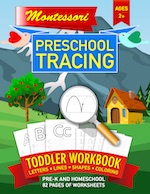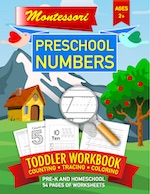The Importance of Tracing Workbooks for Toddlers in Early Education: An In-depth Exploration by Willrose Books

When you purchase through links on our site, we may earn an affiliate commission. As an Amazon Associate I earn from qualifying purchases.
The Power of Tracing Workbooks
In the vast and intricate world of early childhood education, countless activities and exercises play pivotal roles in shaping a child's cognitive, physical, and emotional development. Willrose Books is deeply committed to understanding and promoting these activities, especially in the context of Montessori and preschool environments. Among them, tracing workbooks and coloring exercises stand out as fundamental yet often underemphasized tools. Whether it's practiced in a conventional preschool setting or within the innovative Montessori method, tracing is undeniably a cornerstone in a toddler's developmental journey. In this detailed exploration, we aim to illuminate the multifaceted significance of tracing workbooks for toddlers and delve deeper into its myriad benefits.
1. Tracing Workbooks: A Primer for Toddlers
Before diving into the profound benefits of tracing, it's essential to establish a clear understanding of its nature. In the realm of early childhood pedagogy, tracing is more than just a simple coloring activity. It's an act where children follow a predetermined path or contour, using either their fingers or a writing instrument. This activity can encompass tracing over basic dotted lines, intricate shapes, alphabets, and even elaborate patterns in workbooks. Each form of tracing offers its unique set of challenges and rewards, catering to different developmental needs. Furthermore, tracing serves as a bridge between mere observation and active participation in the Montessori and preschool learning process.
2. The Physical Advantages: Motor Skill Augmentation in Preschoolers
One of the most immediate benefits of tracing in workbooks is its role in refining a toddler's fine motor skills. As these young learners trace various shapes or alphabets, they undergo rigorous training of their hand muscles, performing specific, deliberate movements. This exercise goes beyond just strengthening their hand muscles; it plays a pivotal role in enhancing their hand-eye coordination. Extensive research has consistently demonstrated how tracing acts as a foundational step to more complex skills in both Montessori and traditional preschool settings. These include writing, sketching, and even daily tasks such as buttoning shirts, using cutlery, or tying shoelaces. Moreover, the repetitive nature of tracing reinforces muscle memory, ensuring smoother transitions to advanced tasks.
3. Cognitive Growth Through Tracing Workbooks
Beyond the evident physical benefits, tracing workbooks are a goldmine of cognitive rewards. When a child engages in tracing, they're not just following a pattern; they're learning the art of concentration, understanding the importance of following instructions, and developing the ability to discern patterns. These foundational competencies are the stepping stones for future skills, including reading, arithmetic, problem-solving, and analytical thinking. Additionally, tracing introduces children to the concept of spatial awareness, helping them understand their environment and the objects within it better.
4. The Montessori Method, Coloring, and Tracing
The Montessori philosophy, pioneered by the visionary Dr. Maria Montessori, is a testament to the power of self-guided learning and sensory experiences. Given its tactile nature, tracing and coloring exercises find their rightful place in this pedagogy. Montessori classrooms are equipped with innovative tools like sandpaper alphabets and coloring workbooks, allowing children to trace and physically feel the contours of letters. This tactile approach, combined with visual cues, ensures a deep-rooted and lasting learning experience, catering to multiple learning styles. Furthermore, the Montessori method emphasizes the importance of self-correction, allowing children to recognize and rectify their mistakes, fostering independence and resilience.
5. Tracing Workbooks: A Catalyst for Creativity and Self-assurance in Toddlers
On the surface, tracing might seem like a structured, prescriptive activity. However, as children gain proficiency, it becomes evident that tracing workbooks are a launchpad for creativity. As they master the basics, they often embark on a journey of crafting their unique patterns, designs, and even stories. This exploration not only ignites their imagination but also instills a robust sense of self-belief and individuality. Through tracing, they learn the invaluable lesson that while foundational knowledge is vital, there's an expansive realm of individual expression and innovation waiting to be explored. This balance between structure and freedom is crucial in nurturing well-rounded individuals.
6. Tracing Beyond the Classroom: Making it a Household Activity with Coloring Workbooks
For parents and guardians eager to infuse tracing and coloring into their home environment, here are some invaluable insights:
- Diversify the Medium: Move beyond the confines of paper. Introduce children to tracing on varied surfaces, be it sand trays, rice, or even shaving foam. These tactile variations transform tracing into a thrilling sensory adventure, making learning both fun and effective.
- Narrative-driven Tracing: Infuse storytelling into tracing. For example, trace the journey of a butterfly fluttering from one flower to another or the path a squirrel took to find its acorn. This approach makes tracing more engaging and relatable, fostering a love for both stories and tracing.
- Celebrate Individual Pace: Recognize and celebrate that every child's learning trajectory is unique. While some may naturally gravitate towards tracing and coloring, others might require more time. Cherish each milestone and ensure the activity remains enjoyable, free from undue pressure. Remember, the journey is as important as the destination.
7. The Psychological Benefits of Tracing Workbooks
Beyond its tangible benefits, tracing serves as a potent confidence booster. Successfully tracing patterns and shapes imparts a sense of accomplishment, bolstering a child's self-esteem. This confidence, rooted in early achievements, teaches them that with dedication and persistence, they can conquer any skill, a lesson that remains invaluable throughout life. Moreover, the repetitive nature of tracing offers a therapeutic, calming effect, helping children navigate their emotions and stressors.
8. Tracing, Coloring, and Language Acquisition in Montessori and Preschool Settings
Tracing has consistently shown a strong correlation with language acquisition. As children trace letters in workbooks, they familiarize themselves with their forms, facilitating smoother letter recognition and, subsequently, reading. This hands-on approach to language learning ensures that children not only recognize letters but also understand their structure and significance. Moreover, the rhythmic movement of tracing can be paired with phonetic sounds, further enhancing language skills.
9. The Social Aspect of Tracing Workbooks
Tracing isn't solely an individual activity. It can be transformed into a collaborative endeavor where children trace together, share patterns, and even co-create artworks. Such interactions nurture teamwork, sharing, and effective communication, preparing children for social interactions beyond the classroom. It also fosters a sense of community, teaching children the joys of collective achievement.
Incorporating these activities into a child's daily routine can significantly enhance their tracing skills and provide a holistic learning experience. At Willrose Books, we believe in the power of hands-on learning, and these activities are a testament to our commitment to fostering comprehensive development in children.
10. Montessori-Inspired Tracing Activity Ideas for Toddlers
To further emphasize the importance of tracing and coloring in both Montessori and traditional preschool settings, here are some engaging tracing activities tailored for young learners:
a. Nature Tracing:
Take toddlers outdoors and let them pick leaves, flowers, or twigs. Place these items under a thin sheet of paper and let the child trace the outline. This Montessori-inspired activity not only improves their tracing skills but also fosters a love for nature.
b. Body Outline:
Have the child lie down on a large sheet of paper while another child or adult traces their outline. This preschool activity is not only fun but also helps children understand body parts and their proportions.
c. Texture Tracing:
Introduce toddlers to various textures like corrugated cardboard, lace, or mesh fabric. Let them trace over these textures to feel the different sensations and understand the varied patterns they create.
d. Maze Tracing Workbooks:
Create or print mazes in workbooks that children can trace through. This enhances their problem-solving skills and concentration while they navigate through the maze.
e. Storybook Tracing:
Pick a storybook with large illustrations. Encourage children to trace over the characters or objects, and then narrate the story. This combines tracing with storytelling, enhancing both their tracing and language skills.
11. Advanced Tracing and Coloring Activities for Preschoolers
As children grow, their tracing activities can become more complex, challenging them further:
a. World Map Tracing:
Introduce preschoolers to geography by letting them trace continents, countries, or rivers on a world map. This can be a precursor to more detailed geography lessons.
b. Shadow Tracing:
On a sunny day, place toys or objects in a way that they cast shadows on paper. Let children trace these shadows. This activity introduces them to the concept of light and shadow.
c. Alphabet and Number Tracing Workbooks:
While many tracing books offer this, creating your own set with varying degrees of difficulty can be more engaging. As children master one level, introduce them to a more challenging set.
d. Connect-the-Dots Coloring:
Create or find connect-the-dots pictures in coloring workbooks. This activity not only improves tracing skills but also teaches number sequencing.
e. Tracing with Different Mediums:
Move beyond pencils. Let preschoolers trace with chalk, paint, colored pencils, or even water on a dry surface. Each medium offers a different experience and challenge.
12. Group Tracing Activities in Montessori and Preschool Settings
Promote teamwork with these group activities:
a. Collaborative Art:
Provide a large canvas where children can trace and color collectively, creating a masterpiece as a team.
b. Relay Tracing:
Create a tracing relay where children pass on a tracing task to the next after completing a part, promoting both tracing and teamwork.
c. Pattern Sharing:
Let children create their tracing patterns and share them with peers. Each child then tries tracing another's pattern, promoting sharing and understanding in a Montessori setting.
Incorporating these activities into a child's daily routine, whether in a Montessori or traditional preschool environment, can significantly enhance their tracing and coloring skills. At Willrose Books, we believe in the power of hands-on learning, and these activities are a testament to our commitment to fostering comprehensive development in children.
In Conclusion
In its unassuming simplicity, tracing emerges as a formidable force in early childhood education. Its benefits, spanning physical, cognitive, creative, and social domains, render it indispensable across both traditional and Montessori educational frameworks. At Willrose Books, our mission remains clear and unwavering: to champion activities that foster holistic child development. As we often emphasize, "It's not merely about academic learning; it's about laying the foundation for a lifetime of curiosity, growth, and exploration."




